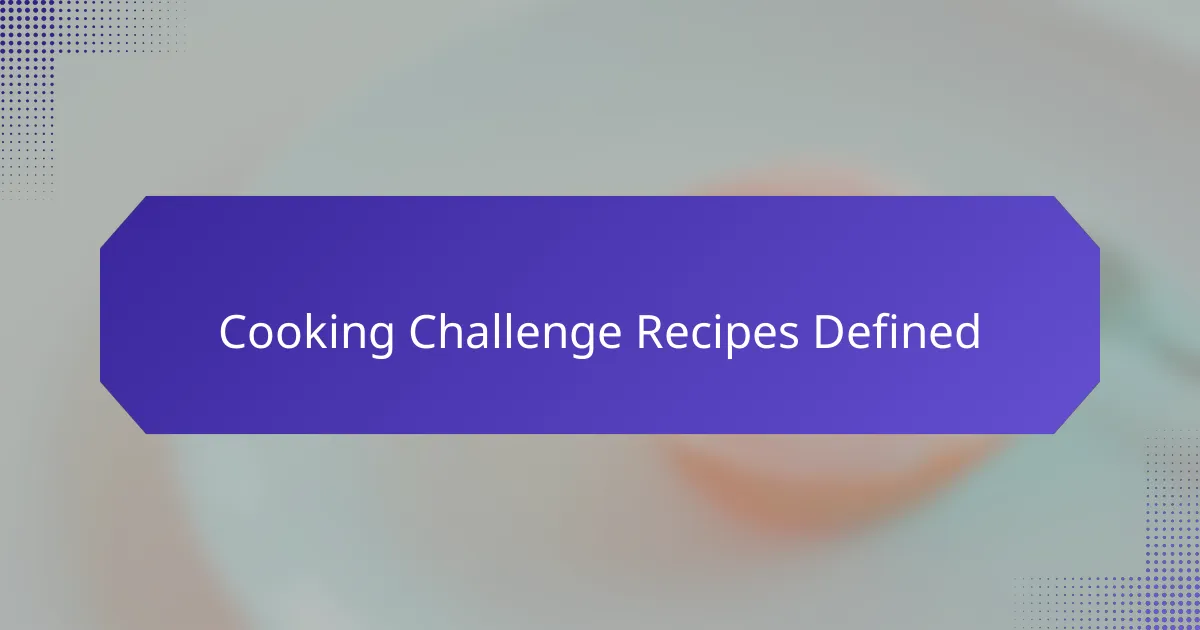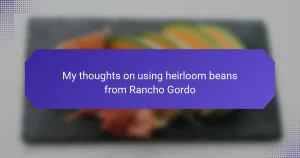Key takeaways
- Cooking challenges promote creativity and experimentation with flavors and techniques.
- Roasting spices enhances their flavor and aroma, creating a more vibrant culinary experience.
- Key spices like cumin, paprika, and oregano greatly enhance dishes when roasted properly.
- Timing and monitoring while roasting spices is crucial to avoid burning and maximize flavor.

Cooking challenge recipes defined
Cooking challenges are not just about culinary skills; they are a journey of creativity and discovery. When I think of cooking challenge recipes, I envision vibrant dishes that push our boundaries and encourage us to try new ingredients and techniques. Each recipe offers an opportunity to explore flavors, like those rich roasted spices from Whole Foods that I absolutely adore.
I’ve often found that participating in a cooking challenge brings out my competitive spirit, but it’s the joy of experimenting with different spices that truly fuels my passion for cooking. Roasting spices can elevate any dish, adding depth and warmth that transforms ordinary meals into extraordinary experiences.
Here’s a comparison of different approaches to cooking challenge recipes:
| Method | Description |
|---|---|
| Traditional | Follows classic techniques and recipes that have stood the test of time. |
| Creative | Encourages innovation by mixing and matching flavors, often inspired by personal preferences. |
| Spice-Focused | Centers around using various spices, like those from Whole Foods, to craft new and exciting flavors. |

Importance of roasting spices
Roasting spices is one of those magical moments in cooking that transforms the entire flavor profile of a dish. I recall the first time I roasted cumin seeds in my kitchen; the nutty aroma filled the air and made my heart flutter with excitement. It’s incredible how a small act can elevate a meal from ordinary to extraordinary.
The importance of roasting spices cannot be overstated. When you take the time to roast, you unlock a depth of flavor that simply can’t be achieved with pre-ground spices. This step not only enhances the aroma but also releases essential oils, bringing out the spices’ full potential.
- Intensifies flavor and aroma, making dishes more vibrant
- Enhances the natural oils in spices, leading to a more robust taste
- Transforms cooking into a sensory experience, engaging smell and taste
- Encourages experimentation and creativity in the kitchen
- Creates a sense of achievement and satisfaction from the cooking process

Benefits of roasting spices
Roasting spices is a game-changer in the culinary world. I’ve often noticed how a simple toasting can intensify flavors and bring out hidden notes that you wouldn’t believe were there. For example, when I roast cumin seeds before grinding them, the aroma that fills the kitchen is nothing short of mesmerizing.
Another benefit is the textural transformation. Roasting spices changes their profile, making them more fragrant and flavorful. I remember the first time I added freshly roasted coriander to a dish; it elevated the meal to another level, creating a warm and inviting atmosphere that had my family asking for seconds.
In terms of health benefits, roasting can also help reduce some of the pungency in spices that may not sit well with everyone. Plus, the added depth of flavor can make healthy dishes more appealing. It’s fascinating how such a simple step can create a more nourishing meal, both for the body and the soul.
| Benefit | Impact |
|---|---|
| Enhanced Flavor | Brings out hidden notes and aromas |
| Textural Changes | Creates a warm and inviting profile |
| Health Boost | Makes healthy dishes more enjoyable |

Essential spices for roasting
When it comes to roasting, I believe the choice of spices can truly elevate the flavors of your dishes. My go-to spices for roasting include paprika, cumin, and dried herbs like oregano. Each brings its own character, enhancing vegetables or meats and creating that mouthwatering aroma we crave.
Another favorite is garlic powder; it offers a punchy flavor without the hassle of peeling and chopping, which I absolutely appreciate on busy days. I find that experimenting with spice combinations not only brings joy to my cooking but also encourages creativity in the kitchen, making every meal feel like a new adventure.
Here’s a handy comparison of essential spices for roasting based on flavor, aroma, and versatility:
| Spice | Flavor Profile | Aroma | Versatility |
|---|---|---|---|
| Paprika | Sweet and Smoky | Rich and Warm | Great for meats and vegetables |
| Cumin | Earthy and Nutty | Pungent and Spicy | Ideal for Mediterranean and Mexican dishes |
| Oregano | Herbaceous and Savory | Fragrant and Fresh | Perfect for roasted chicken and vegetables |
| Garlic Powder | Bold and Savory | Robust and Inviting | Works with virtually any roasted dish |

My roasting technique preferences
When it comes to roasting spices, I find that the technique truly makes all the difference. I typically use a dry skillet over medium heat to release those wonderful essential oils, which instantly transforms the spices. The first time I tried this method, I was amazed at how much more intense the flavors became, bringing a whole new dimension to my dishes.
Another aspect I pay close attention to is the timing and monitoring. I remember the first time I let a batch of cumin seeds roast just a bit too long— it turned from wonderful to burnt in seconds! Now, I make sure to swirl the skillet regularly and keep a close eye on the color and aroma.
- Dry roasting over medium heat enhances flavor.
- Use a skillet to easily monitor the roasting process.
- Stir frequently to prevent burning, as timing is crucial.
- Always trust your nose; the aroma is the best indicator that spices are ready.

Personal experiences with Whole Foods spices
When I walk into Whole Foods, the aroma of their spice section instantly draws me in. I remember the first time I roasted a blend of Indian spices from their selection. The flavors were so vibrant, it transformed my ordinary dish into something extraordinary, and I felt an immense sense of accomplishment and joy in my cooking.
My experiences with these spices have truly been a game-changer in my kitchen. I love experimenting with different combinations, taking a simple vegetable roast to another level. Here’s a quick list of my favorites and how they’ve impacted my cooking:
- Cumin: Adds a warm, earthy flavor perfect for stews and roasted veggies.
- Smoked Paprika: Infuses a subtle smokiness that’s great for meats and even popcorn.
- Coriander: Brightens up dishes with its citrusy notes, especially in grain salads.
- Cardamom: A pinch of this in my morning oatmeal gives it a delightful twist that I just can’t resist.
These spices not only enhance the taste but also ignite my passion for cooking.

Tips for perfecting roasted spices
When it comes to perfecting roasted spices, I’ve discovered that timing is everything. Start with low heat to release flavors gently, then gradually increase it. I remember the first time I roasted cumin seeds – the aroma filled my kitchen, and it transformed my dish from good to irresistible.
Another tip I’ve learned is to keep a close eye on spices as they roast. They can go from perfectly toasted to burnt in a matter of seconds! I often find that stirring them halfway through helps ensure an even roast. Trust me, the extra minute of attentiveness is worth it for that depth of flavor.
Lastly, don’t underestimate the power of a good grinder. Freshly ground roasted spices pack a punch in taste. I still recall the first time I used freshly ground coriander in a recipe – it was a game changer. These small adjustments can elevate your cooking to a whole new level.
| Tip | Description |
|---|---|
| Use Low Heat | Begin at a lower temperature to gently release flavors before increasing heat. |
| Stir Frequently | Stir spices halfway through roasting to ensure even roasting. |
| Fresh Grinding | Always grind your spices fresh for maximum flavor impact. |


